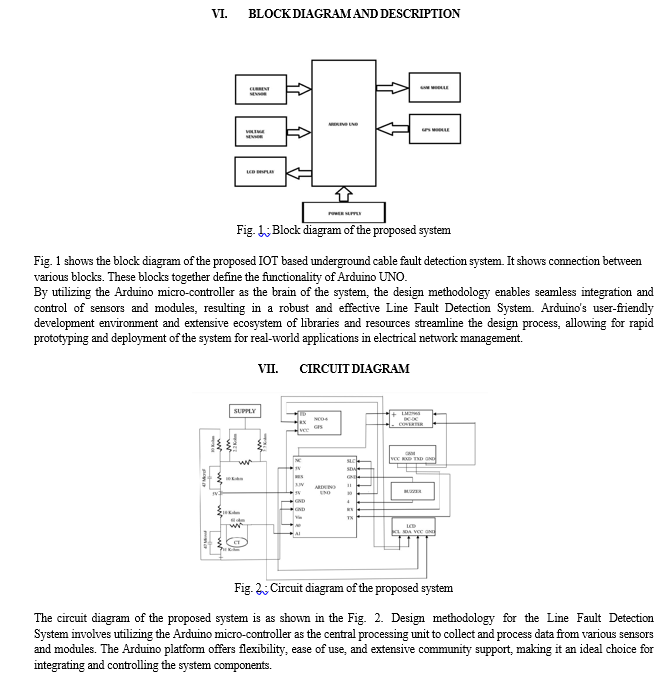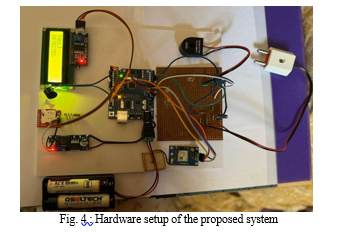Ijraset Journal For Research in Applied Science and Engineering Technology
- Home / Ijraset
- On This Page
- Abstract
- Introduction
- Conclusion
- References
- Copyright
IOT Based Underground Cable Fault Detection System
Authors: Chaitrashree S R, Bhavana B Raj, Chaithanya HR, Jahnavi N
DOI Link: https://doi.org/10.22214/ijraset.2024.63229
Certificate: View Certificate
Abstract
The Underground Cable Fault Detection System outlined in this project represents a significant advancement in the field of electrical network management, addressing the pressing need for real-time monitoring and proactive fault detection. By integrating cutting-edge sensor technologies, including AC current and voltage sensors, alongside GSM and GPS modules, the system offers a comprehensive solution for identifying and responding to critical events in electrical infrastructure. The primary objective of this system is to enhance the reliability, safety, and efficiency of electrical networks by enabling swift detection and resolution of faults. Through continuous monitoring of current and voltage levels, the system can identify abnormalities such as over-voltage, under-voltage, and over-loading in real-time. Upon detection of these conditions, automated SMS alerts are promptly dispatched to designated authorities, providing instant notification of the issue and its precise location via GPS coordinates. This immediate response mechanism facilitates rapid intervention and maintenance, minimizing downtime and mitigating potential risks to the electrical system\'s integrity.
Introduction
I. INTRODUCTION
In an era characterized by increasing reliance on electricity for virtually every aspect of modern life, the importance of maintaining a robust and reliable electrical infrastructure cannot be overstated. From powering homes and businesses to driving industrial machinery and supporting critical infrastructure, the uninterrupted flow of electricity is essential for sustaining economic growth, ensuring public safety, and enhancing quality of life.
However, the complexity and scale of modern electrical networks pose significant challenges in terms of monitoring, maintenance, and fault detection. Traditional methods of fault detection often rely on manual inspection or periodic checks, which are time-consuming, labor-intensive, and prone to human error.
Moreover, the lack of real-time communication between the infrastructure and maintenance personnel hampers the timely identification and resolution of faults, leading to prolonged downtime, increased costs, and potential safety hazards.
Electrical energy is generated in the generating station and then it is distributed to the different loads at different areas for consumption through step-up and step-down transformers. Distribution of electrical energy is done via electric cables. The complexity of the whole network comprises numerous components that can fail and interrupt the power supply for the end user. For most of the worldwide operated low voltage and medium voltage distribution lines, underground cables have been used for many decades. Underground high voltage cables are used more and more because they are not influenced by weather conditions, heavy rain, storms, snow and pollution. Even though the Cable manufacturing technology is improving steadily; there are still influences which may cause cable to fail during test and operation.
A cable in good condition and installed correctly can last a lifetime of about 30 years. However, cables can be easily damaged by incorrect installation or poorly executed jointing, while subsequent third-party damage by civil works such as trenching or curb edging. Study of cable failures and development of accurate fault detection and location methods has been interesting research topics in the past and present. Fault detection entails determination of the presence of a fault, while fault location detection includes the determination of the physical location of the fault. However, this fault detection and fault location detection technology for underground power distribution systems is still in developing stages.
The primary objective of the Underground Cable Fault Detection System is to enhance the reliability, safety, and efficiency of electrical networks by enabling proactive fault detection and swift response to critical events. By automating the monitoring process and facilitating real-time communication between the infrastructure and maintenance personnel, the system reduces downtime, minimizes operational disruptions, and mitigates potential risks to the integrity of the electrical system.
II. PROBLEM STATEMENT
Conventional methods of fault detection in electrical networks often rely on manual inspection or periodic checks, leading to delayed identification of issues and increased downtime. Moreover, the lack of real-time communication between the infrastructure and maintenance personnel hinders timely responses to critical events.
The Underground cable Fault Detection System addresses these challenges by automating the monitoring process and enabling instant alerts to relevant stakeholders.
Traditional methods of fault detection in electrical networks suffer from limitations such as manual inspection, periodic checks, and lack of real-time communication. These shortcomings result in delayed identification of faults, increased downtime, and potential safety hazards. The absence of proactive monitoring exacerbates the risks associated with over-voltage, under-voltage, and overloading conditions, compromising the reliability and integrity of the electrical system. Addressing these challenges is crucial for ensuring the uninterrupted flow of electricity, minimizing operational disruptions, and safeguarding public safety.
The Underground cable Fault Detection System aims to overcome these obstacles by providing real-time monitoring, proactive fault detection, and prompt alerting of critical events.
III. OBJECTIVES
- Develop a robust fault detection system for electrical lines.
- Integrate AC current and voltage sensors for real-time monitoring.
- Implement GSM and GPS modules for remote alerting and location tracking and Enable automatic SMS alerts to authorities in case of over-voltage, under-voltage, and overloading conditions.
- Enhance the reliability and efficiency of electrical network management.
???????IV. SCOPE OF THE PROJECT
- By Implementation of a robust system to detect faults in the underground cables.
- Setup of a system to collect data from sensors and underground cable and establishment of communication between the fault area and control room.
- Develop an application to track the location of the fault area and created a system to send an alert message to pre - registered mobile number when fault is occurred.
???????V. METHEDOLOGY
A. Existing System
The existing system for fault detection in electrical networks typically relies on manual inspection, periodic maintenance checks, and limited automation. In this conventional approach, technicians conduct visual inspections of electrical equipment and infrastructure at regular intervals, looking for signs of wear, damage, or abnormal operation. Additionally, periodic tests may be performed to measure voltage, current, and other parameters, but these tests are often infrequent and may not capture real-time data.
One of the primary limitations of the existing system is its reactive nature. Faults and abnormalities are typically identified only after they have already occurred, leading to delayed responses and increased downtime. Moreover, the lack of real-time communication between the infrastructure and maintenance personnel hinders the timely identification and resolution of issues, potentially compromising the reliability and safety of the electrical system.
Some of the methods used to locate faults in Real - Time underground cables are classified as follows :-
- Online Method: This method utilizes the process of the sampled voltages & current to determine the fault points. The online method for underground cable is less than overhead lines.
- Offline Method: In this method a special instrument is used to test out the service of cable in the field. There are two offline methods as follows:
a. Tracer Method: In this method fault point is detected by walking on the cable lines. The fault point is indicated from audible signal or electromagnetic signal. It is used to pinpoint fault location very accurately.
Ex:
i) Tracing current method.
ii) Sheath coil method.
b. Terminal Method: It is a technique used to detect fault location of cable from one or both ends without tracing. The voltage drop varies with the default length on the cable, as the current varies. A plurality of resistors is used to represent the cable and a DC voltage is supplied at one end and the defect detected by detecting the voltage variation the defect area to accelerate the tracking of the buried cable. Here we mainly concentrate on the open circuit fault detection system and location tracking with message alert in any mode.
Ex:
i) Murray loop method.
ii) Impulse current method
Overall, the existing system for fault detection in electrical networks is characterized by manual intervention, limited automation, and reactive maintenance practices. While these methods may suffice for routine inspections and periodic checks, they fall short in terms of real-time monitoring, proactive fault detection, and rapid response to critical events. As such, there is a pressing need for more advanced and integrated solutions, such as the proposed Underground Cable Fault Detection System, to address these shortcomings and enhance the reliability and efficiency of electrical network management.
B. Proposed System
The proposed Underground Cable Fault Detection System integrates a sophisticated array of components to create a comprehensive solution for monitoring and managing electrical networks. At its core are AC current and voltage sensors, which continuously monitor the electrical parameters of the network in real-time. These sensors provide accurate measurements of current flow and voltage levels, enabling early detection of abnormalities such as over-voltage, under-voltage, and over-loading conditions.
Complementing the sensor array are GSM (Global System for Mobile Communications) and GPS (Global Positioning System) modules, which add advanced communication and location tracking capabilities to the system. When anomalies are detected by the sensors, the system automatically triggers the GSM module to send SMS alerts to designated authorities, providing instant notification of the issue. Simultaneously, the GPS module provides precise coordinates of the fault location, enabling rapid intervention and maintenance by guiding personnel to the site of the fault.
By integrating these components, the proposed system offers a proactive approach to fault detection and management, enabling utilities, industries, and communities to enhance the reliability, safety, and efficiency of their electrical infrastructure. With its ability to provide real-time monitoring, remote communication, and precise location tracking, the Underground Cable Fault Detection System represents a significant advancement in the field of electrical network management, offering unparalleled capabilities for ensuring uninterrupted power supply and safeguarding critical infrastructure.
The methedology implied in the proposed Underground Cable Fault Detection System is as follows :-
- Selection of appropriate AC current and voltage sensors for accurate monitoring.
- Integration of GSM and GPS modules for remote communication and location tracking.
- Development of a micro-controller based system for real-time fault detection and alert generation.
- Testing and validation of the system under various operating conditions to ensure reliability and accuracy.
Selection of Voltage and Current Sensors: Arduino-compatible voltage and current sensors are chosen based on their compatibility with the micro-controller platform and their ability to provide accurate measurements of electrical parameters. Sensors with analog or digital output interfaces are preferred for seamless integration with Arduino boards. Examples include voltage dividers for voltage sensing and Hall effect sensors for current sensing.
Integration of GSM and GPS Modules: GSM and GPS modules compatible with Arduino are selected to facilitate remote communication and location tracking. Arduino libraries and communication protocols compatible with these modules are utilized to establish communication and retrieve data. For instance, SIM800L GSM modules and SIM808 GPS/GSM modules are commonly used with Arduino for SMS communication and GPS positioning, respectively.
Arduino Micro-controller Unit and System Integration: The Arduino micro-controller serves as the central processing unit, responsible for interfacing with sensors, processing data, and controlling external modules. Arduino boards such as Arduino Uno or Arduino Mega are commonly used due to their versatility and compatibility with a wide range of sensors and modules. Software development involves writing firmware using the Arduino IDE and libraries to configure sensor inputs, handle communication with GSM and GPS modules, and trigger actions based on detected faults.
System Integration and Testing: System integration involves connecting sensors, GSM and GPS modules, and other peripherals to the Arduino board, configuring communication interfaces, and writing code to implement fault detection algorithms. Testing and validation are conducted to ensure the reliability and accuracy of the system under various operating conditions. This includes testing sensor readings, GSM communication, GPS positioning, and the overall responsiveness of the system to simulated fault conditions.



IX. ADVANTAGES
- The Underground Cable Fault Detection System offers real-time monitoring of electrical parameters, enabling prompt detection of abnormalities such as over-voltage, under-voltage, and overloading.
- Integration of GSM modules allows for remote communication with authorities, enabling instant alerting of critical events and facilitating rapid response and maintenance.
- The inclusion of GPS modules provides precise coordinates of fault locations, aiding maintenance personnel in quickly locating and addressing issues.
- By enabling proactive fault detection and timely intervention, the system enhances the reliability and uptime of electrical networks, minimizing downtime and operational disruptions.
- The system enhances safety for maintenance personnel by providing early warning of potential hazards such as overloading or equipment malfunction, allowing for timely intervention and preventive measures.
???????X. APPLICATIONS
Some of the applications where our proposed Underground Cable Fault Detection System can be implemented are listed below :-
- Telecommunication Networks: Underground fiber optic and copper cables are vital for telecom infrastructure. Rapid fault detection and location minimize service disruptions for phone and internet users.
- Oil and Gas Pipelines: Early detection of leaks in underground pipelines prevents environmental damage and economic losses.
- Transportation Systems: Traffic light networks, railway signaling systems, and even electric vehicle charging infrastructure rely on underground cables. Fast and accurate fault detection keeps these systems operational and ensures public safety.
- Smart Cities: The growing network of sensors and devices in smart cities relies heavily on underground cables. Efficient fault detection is crucial for maintaining functionality of everything from traffic management systems to smart lighting.
- Industrial Automation: Manufacturing facilities and industrial plants have complex networks of underground cables supplying power and control signals. Early detection of faults minimizes production downtime and ensures safety.
XI. FUTURE SCOPE
Current systems primarily focus on short-circuit faults. Future iterations could incorporate advanced signal processing techniques to identify a wider range of faults, including partial discharge, insulation degradation, and overheating. This would enable preventive maintenance and prevent catastrophic failures. While current systems provide a general location based on sensor placement, future developments might involve integrating techniques like distributed sensor networks, time-domain refractometer, or machine learning algorithms.
These advancements could pinpoint the fault location with much greater precision, minimizing excavation areas and repair time.
Machine learning algorithms can analyze vast amounts of historical data to predict potential faults and identify patterns. This predictive maintenance approach could optimize resource allocation and prevent outages before they occur.
As reliance on IoT increases, robust cyber-security protocols are crucial. Future systems will likely incorporate advanced encryption and access control mechanisms to safeguard sensitive data from cyber-attacks.
Conclusion
The proposed project is done to discover the location of fault in cable lines from the base station to precise location. The underground cable fault detection system presented in this project offers a comprehensive solution for enhancing the monitoring and management of electrical networks. By leveraging advanced sensor technologies and communication modules, the system enables real-time detection of faults and prompt alerting of relevant authorities. Despite certain Future research can explore advancements in sensor technology, data analytics, and machine learning algorithms to further improve the accuracy, efficiency, and scalability of underground cable fault detection systems. Additionally, exploring the integration of renewable energy sources and distributed energy resources with the IoT - based grid management systems can pave the way for a more sustainable and resilient energy future. The hardware setup of the proposed underground cable fault detection system is shown in the above Fig. 4.
References
[1] Jitendra Pal Singh, Sanjana Singh, Toshika Singh & Mohd. Shahrukh? “Underground cable fault distance locator” . (IJSRMS) - ISSN : 2349-3771 - VOL 3 Issue 1, pg: 21-26. [2] Priyanka R and Priya B - “Underground Cable Fault Detection”. - (IJTRD) - ISSN - 2394-9333, VOL 3 - Issue-3, June 2016. [3] Nikhil Kumar Sain, Rajesh Kajla, and Mr. Vikas Kumar - “Underground Cable Fault Distance Conveyed Over GSM”. (ISRO-JEEE) - eISSN: 2278-1676,p-ISSN: 2230-3331, VOL 11,Issue 2 Ver.III (Mar. - Apr. 2016). [4] Md. Fakhrul Islam, Amanullah M T Oo, Salahuddin. A. Azad, ? “Locating Underground Cable Faults: A Review and Guideline for New Development”. - 2013 IEEE [5] Hartono, Lantip Pramono and Yusup Azizi - “Design of Ground Fault Detector Using Node MCU ESP8266 microcontroller Based Telegram” - IOP Publishing. [6] Prasad D. Kadam, M, Ajita Nigam, Vipin Pandey and Subhashini Samal - “Underground Cable Fault Detection Using IOT”. (IJRET) e-ISSN: 2395-0056, p-ISSN: 2395-0072, VOL-7, Issue-4, April 2020. [7] S. Madhavi, D. Durga Bhavani, Ch. Harika, B. Vineela, P.V.S. Sruthi Mrunalini - “Estimation of Open & Short Circuit Fault Distances in the Underground Cable using Arduino & GSM Module”. - (IJECT) ISSN : 2230-7109, VOL-8, Issue-2, April-June 2017. [8] Himanshu Katara - “Fault Detection System of Underground Cables”.- (IJITEE) ISSN: 2278-3075, VOL-8, Issue-12S, October 2019. [9] Dr: Kanta Prasad Sharma, Laxmi Goswami, Manish Kumar Kaushik, Rishi Sikka, Vinay Anand and Madhav Singh Solanki - “IOT Based Fault Detection of Underground Cables through Node MCU Module”. Researchgate Conference Paper, DOI: 10.1109/ICCSEA49143.2020.9132893 - March 2020.
Copyright
Copyright © 2024 Chaitrashree S R, Bhavana B Raj, Chaithanya HR, Jahnavi N. This is an open access article distributed under the Creative Commons Attribution License, which permits unrestricted use, distribution, and reproduction in any medium, provided the original work is properly cited.

Download Paper
Paper Id : IJRASET63229
Publish Date : 2024-06-10
ISSN : 2321-9653
Publisher Name : IJRASET
DOI Link : Click Here
 Submit Paper Online
Submit Paper Online

